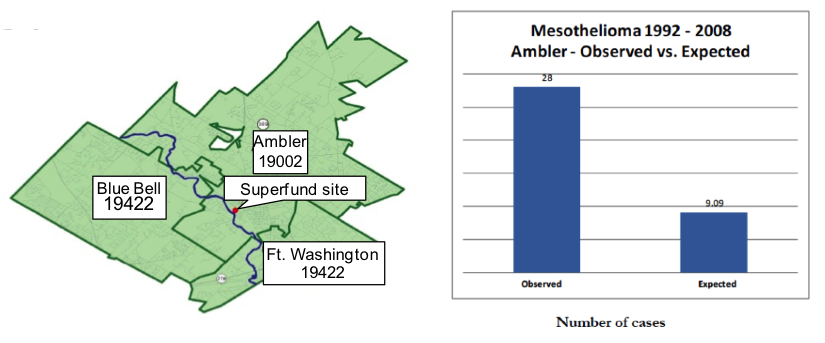Project 3: Social Determinants of Risk and Attitudes About Asbestos in a Superfund Environmental Justice Community
Significance
The broad objective of Project 3 is to conduct an environmental epidemiologic and ethnographic study of asbestos-related disease among residents of Ambler, Pennsylvania, one of the largest asbestos waste sites in the US where there was substantial industrial and community exposure to asbestos from the late 1800s through the late 1980s. The known adverse health effects of asbestos exposure in work settings raise the possibility of analogous effects from community level exposure.

The Pennsylvania Department of Health has identified in the Pennsylvania Cancer Registry an excess of cases of mesothelioma in the Ambler zip code, finding a 2.7 times higher than expected rate among men and a 4.5 times higher than expected rate among women. However, a combination of circumstances including out-migration of families from the area following closure of the asbestos industry, the long latency period characteristic of asbestos related diseases, the under-reporting of lung diseases in earlier periods, and the mismatch between administrative boundaries and actual exposure to asbestos, may have affected the ability of standard public health surveillance methods to fully capture the magnitude of the problem in this area.
Project 3 proposes to build on Department of Health findings and on our own previous pilot work in which we used ethnographic methods to delineate parameters of the relevant communities of exposure and to describe normative lifestyle patterns and circumstances of potential asbestos exposure. In the process of developing these data, we have formed strong relationships with these communities which will facilitate our access to current and past residents and workers to conduct a geographic case control study to analyze the contribution of community, occupational and social factors among individuals who developed mesothelioma. Specifically, we will determine the association between the development of mesothelioma and geographic proximity to the plant and asbestos waste piles that had been publicly discarded in the Ambler area.
Hypothesis
The study design of Project 3 is based on the following hypotheses:
- The incidence of mesothelioma is related to both occupational and non-occupational (community exposures) in the Ambler area;
- There is an association between the incidence of mesothelioma and proximity of residence to the asbestos waste sites and
- The relationships between proximity to the site and mesothelioma are modified by various social, lifestyle and economic factors that influence asbestos exposure.
These hypotheses will be tested under the following Specific Aims:
- To utilize an ethnographic approach with residents to identify patterns of exposure related to lifestyle and social factors to inform the case control analysis.
- To identify, characterize and map all cases of mesothelioma in Ambler Borough and the four adjacent townships.
- To identify a set of controls that are frequency matched with cases based upon a minimum five year residence in the area .
- To use a geographic case-control design to characterize the contribution of geographic factors found among people who developed mesothelioma in the greater Ambler area.
Project 3 is tied closely to the outcomes from Projects 1 and 2. There is significant community concern about risks posed by planned remediation efforts and by risk from the movement of asbestos fibers through air and water. The database that will be developed in Project 3 of community members potentially exposed to asbestos will be shared with Project 6 so that residents can be contacted to participate in prospective studies of biomarkers.
Project 3 is an ethnographic and epidemiologic study that links directly with all of the Cores in the Center. The project addresses a fundamental concern of community members and thus will relate directly with the Community Engagement Core by providing findings about risk that will need to be communicated appropriately to community members and stakeholders. In the process of conducting the preliminary ethnographic work, the Community Engagement Core will provide access to community stakeholders who can inform the design and process of data collection.
The Biostatistical Research Support Core has provided input into the development of this proposal and will provide data management and statistical analysis services for Aims 2-4. The Research Translation Core will assist in the dissemination of findings within the local community and, importantly, to agencies such as the EPA, the ATSDR and the Pennsylvania Department of Health so that the benefit of our work is useful to other Superfund communities. Findings will also be incorporated into educational seminars and workshops for trainees and fellows in the Interdisciplinary Training Core. Finally, the Administrative Core will provide overall direction and financial oversight.
Project Leaders
Frances K. Barg, PhD, MEd, Project Leader
Associate Professor, Department of Family Medicine and Community Health, Perelman School of Medicine, University of Pennsylvania
Fran.Barg@uphs.upenn.edu
Douglas Wiebe, PhD, Co-Project Leader
Associate Professor, Department of Biostatistics and Epidemiology, Perelman School of Medicine, University of Pennsylvania
dwiebe@upenn.edu
Publications
Click Here to view all publications

